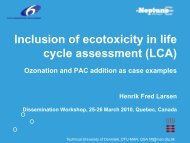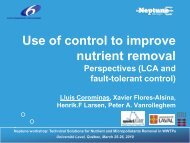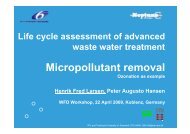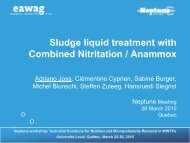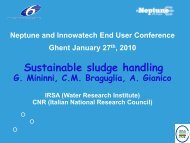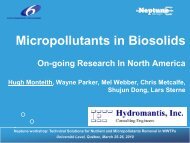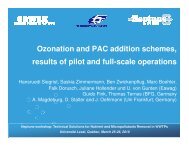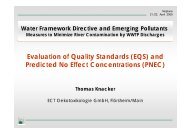D2.1 - EU Project Neptune
D2.1 - EU Project Neptune
D2.1 - EU Project Neptune
You also want an ePaper? Increase the reach of your titles
YUMPU automatically turns print PDFs into web optimized ePapers that Google loves.
NEPTUNE · Contract-No. 036845 Deliverable 2.1<br />
4.2 Recovery of organics: Production of biopolymers from<br />
biosolids<br />
4.2.1 Background<br />
Biosolids is the term used to describe the solid by-products from sewage treatment<br />
processes. Biosolids are a burden for the operation of wastewater treatment plants since<br />
handling and disposing of biosolids are a major cost and can cause long-term greenhouse<br />
gas emissions if landfilled. In the context of this technology, however, biosolids represent a<br />
high volume, renewable resource rich in carbon, nitrogen and phosphorus that can be<br />
transformed into usable products, i.e., bioplastics and energy (Figure 4.8). Bioplastics, such<br />
as polyhydroxyalkanoates (PHAs), are polymers synthesised by bacteria and can be<br />
degraded biologically and be reintegrated into the Earth's short-term carbon cycle, in contrast<br />
to conventional oil-based plastics currently being extensively used. Therefore, the objectives<br />
of the proposed process and technology developed during this research project are: (i) to<br />
maximise the production of volatile fatty acids (VFAs) to be used as feedstock for biopolymer<br />
synthesis from pretreated waste activated sludge (WAS), and (ii) to produce optimally PHAs<br />
based on this VFA-rich stream.<br />
Figure 4.8 Strategy for utilising biosolids to produce biopolymers and energy. Volatile<br />
fatty acids (VFAs) produced during fermentation are the ideal feedstock for<br />
biopolymer production.<br />
4.2.2 Potential areas of application<br />
PHA bioplastics can replace parts of the market of conventional plastics such as<br />
polypropylene and polyethylene since PHAs possess similar thermoplastic properties (Lee,<br />
1996). Furthermore, PHAs can be produced by open, mixed bacterial cultures utilising<br />
inexpensive and renewable carbon sources, namely waste streams, e.g., fermented<br />
pretreated biosolids.<br />
The technology investigated in this research is directly applicable to the wastewater<br />
treatment industry as the feedstock, biosolids, is generally an unwanted by-product. For<br />
example, a moderate sized wastewater treatment facility (500 000 PE) handles in the order<br />
32



